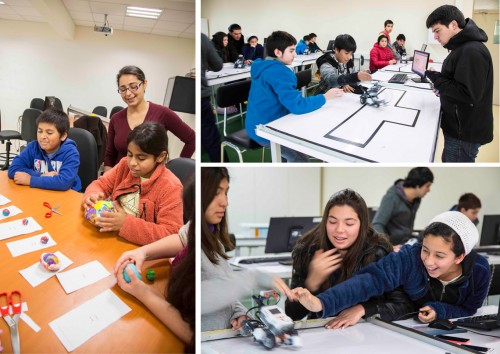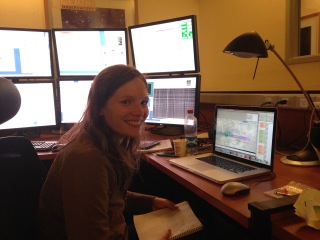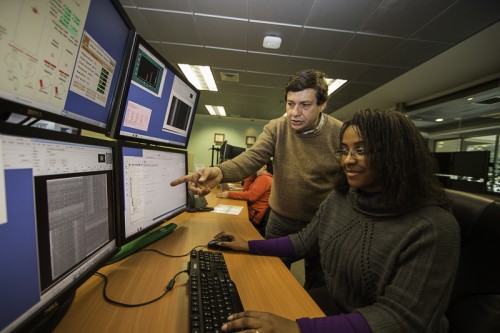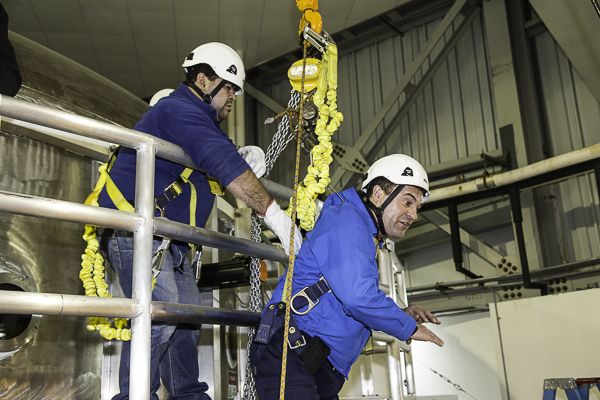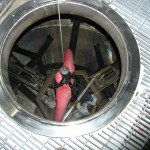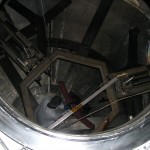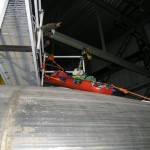2015 AURA Service Awards

(left to right) Markus Kissler-Patig, Chad Trujillo, Kathleen Lebrie, Bobbi Kikuchi, Scot Klienman, Janice Harvey, and Jeff Donahue
SCIENCE AWARD
Nominee: Chad Trujillo in recognition of his research on Kuiper Belt Objects
Gemini is pleased to nominate Chad Trujillo, Astronomer at Gemini North, for the AURA Science Award. Chad’s research concentrates on the Solar System and its distant reaches, including Kuiper Belt Objects. He is an active scientist and recognized expert in the field.
Chad and his primary collaborator, Scott Sheppard (Carnegie), have produced alone, or led, many significant discoveries recently, including two exceptional ones in the last year. One open question is the relationship between the Kuiper Belt (at distances of 30–40 Astronomical Units; AU) and the Oort Cloud, which extends to distances of 10,000 AU. Various formation models of the Solar System make different predictions (e.g., for the capture of extrasolar planetesimals or stellar encounters to populate the Oort Cloud). One previous connection between these areas is the dwarf planet Sedna, but as a single object it may not be representative. Trujillo and Sheppard (2014 Nature 507 471) reported the discovery of second similar body, 2012 VP113, at a perihelion distance of 80 AU. They suggest that both objects could be members of the inner Oort Cloud, which also argues for a large population in this part of the Solar System, though with most members at larger perihelion.
Their latest work (Sheppard & Trujillo 2015 The Astrophysical Journal 149 44) reports the discovery and characterization of an active asteroid. The body, (62412) 2000 SY178, orbits in the main asteroid belt. It is active in the sense of exhibiting comet-like extended emission due to the ejection of dust and gas. In this case, the measured rapid rotation may directly contribute to the ejection of material from the surface, or indirectly assist by exposing ice as material moves around the surface. The pair classifies the asteroid as a member of the Hygiea family, based on orbit and color. It is the first active member of this large family.
These specific results and Chad’s broader body of recent work reveal how much of the Solar System is yet to be discovered. The outer extent of the Solar System provides some of the best evidence for its formation history, yet most of its contents have not been measured well or even identified. The small bodies of the inner Solar System offer a longer history of study, yet even they continue to reveal details of their composition, which is tied to the chemistry of the early Solar System and planet formation.
With his two milestone papers in the last year, Chad Trujillo strengthened his reputation as an international leader in Outer Solar System research.
SERVICE AWARD
Nominee: Janice Harvey in recognition of Journey Through the Universe’s 10th anniversary
In 2014 Gemini’s flagship outreach program Journey Through the Universe (JTTU) reached the remarkable milestone of its 10th anniversary. Achieving this milestone, while a team effort that spans the entire Gemini staff, was only possible due to the tireless efforts of Gemini’s Janice Harvey. For the past 10 years Janice has shepherded the program from its humble beginnings with a few Gemini scientists and engineers visiting local classrooms to what it is today, with dozens of participants from across Hawaii and the country. The program has become a model of observatory community engagement and has received broad recognition and support ranging from the local Department of Education, to area businesses – even NASA sends (and funds) several educators to participate based on the program’s reputation.
In 2014 over 50 classroom educators participated in the JTTU program and engaged over 3000 Hawai’i students. In addition to classroom presentations, teacher workshops engaged educators, family science events connected families, public lectures wowed audiences, and a highly successful career panel inspired local students.
Janice’s ability to engage all aspects of the community in the program is exemplified by the annual Chamber of Commerce’s “Thank You” celebration. This annual who’s-who event attracts essentially all of the community’s key business and political leaders (this event has seen the state Governor, local mayors, and representatives participate).
Measured by the recognition that the program receives from our community, educators, and leaders, this program is Gemini’s most influential activity in our local host communities. Collectively, Janice, and the program, has/have received countless awards and it is appropriate that AURA recognize Janice for her efforts in leading this program. Thanks, in large part, to Janice’s efforts, JTTU is a model for effective interaction with our local host communities.
Finally, Janice’s hard work, dedication, and enthusiasm support Gemini’s goal to explore the universe, and especially, share its wonders.
TECHNOLOGY/INNOVATION AWARD
Nominees: Jeff Donahue and Cristian Moreno in recognition their work on Gemini’s lasers
Jeff and Cristian went above and beyond their duties in 2014 to keep both lasers at Gemini North and South working throughout a critical year, and to prepare laser operations without aircraft spotters.
Jeff and Cristain are responsible for delivering laser operations; Jeff at both sites, and Cristian in the south. The Lockheed-Martin Coherent Technologies (LMCT) lasers are complex and require a significant amount of technical intervention to maintain. Regular, smooth operations is not achieved with these systems without a lot of dedicated work. With the passing of Vincent Fesquet, the only full-time Gemini laser engineer, in late 2013, responsibility for these systems fell squarely on Jeff and Cristian at a time when the Gemini South (GS) laser was gearing itself up to become a serious operational issue. Supported by such external engineering expertise as they were able to assemble, the two worked tirelessly to bring the GS laser back into operations. This was perhaps the highest-pressure operational situation within the observatory in the past years: GeMS runs are scheduled on a more or less monthly basis through the southern spring, summer and autumn, and the pressure to get reasonable laser power in time for each run is intense. This was not always possible in 2014 but the team has persisted and by early 2015 was delivering enough power to enable the January GeMS run, even during that period of low sodium return.
Most of the case for this award centers on the Gemini South LMCT laser system. This system, brought into operation in early 2013, has proved very difficult to optimize. The death of Vincent Fesquet came before the system was truly stable, and the period thereafter was particularly taxing as the power output level plummeted for a variety of reasons. Jeff immediately jumped in and began searching for solutions. He was 100% willing to travel to Chile and work with Cristian to protect the science program, and put a great deal of effort into getting contracts for the support of a variety of engineers not employed by Gemini. Jeff was central to the effort to get the laser back. In doing so, he also made sure that his duties were 100% covered for the Gemini North (GN) laser system, which involved Jeff prepping for the GN laser runs, hopping on a plane the next day to Chile, and flying back to Hawaii in time to go up Maunakea to prep the GN laser the day after arriving back home from Chile. Cristian was in a difficult situation due to export license restrictions on his ability to work on the laser unsupervised and when the visiting engineer was present, to pick up on procedures; however he stuck to the task and his skills developed over the year. When the laser was brought down by a power failure, such as inevitably happened just before the 2015 January GeMS run, he was able to smoothly recover its performance.
Both Jeff and Cristian have gone above and beyond in the course of a tumultuous year for the GS laser. Whether for making sure arrangements were put in place to bring in expertise to recover the system’s performance, assisting with the work, or responding to emergencies and generally supporting the system, both of them deserve recognition for enabling science which without their efforts would almost certainly not have been possible. Simultaneously, Jeff pushed along the Transponder-Based Aircraft Detector (TBAD) system, which will enable laser operations without spotters. He organized a multi-observatory one-day workshop in which the designer of TBAD came to Hawaii and demonstrated its capabilities, and worked with the Base Facility Operations team to see that it was installed at both sites. This has involved Jeff in a lot of interactions with external agencies such as the FAA and we now anticipate the first spotter-free observing with the Gemini North laser by April 2015. This work involves a lot of people but Jeff has been a central figure.
TEAM AWARD
Nominee: Gemini Planet Imager team at STScI and Gemini Observatory
STScI and the Gemini Observatory would like to jointly nominate for the AURA team award: the Gemini Planet Imager Team at Gemini and the Space Telescope Science Institute (STScI).
Back in 2003, some of the world’s foremost astronomers and instrument builders got together in Aspen, Colorado to develop a vision for the future of observational astronomy at Gemini Observatory. Ten years later, some of the key tenets of that vision: understanding the nature and statistics of extra solar planets, and the development of extreme adaptive optics have been realized with the successful delivery and first light data taken with the Gemini Planet Imager, GPI. With its powerful adaptive optics system, innovative high contrast coronagraph and calibration systems, and state of the art integral field unit spectrograph, GPI is now the world’s premier planet finding instrument. It is also the most expensive and complex instrument ever built for Gemini. The process used to build GPI and manage the project was based on years of experience in past instruments at Gemini and represented a substantially new way to bring instruments to the telescopes.
There was close interaction between the external teams (from 6 main and various contributing institutions) and Gemini and STScI staff, resulting in a team unified in its mission to bring this powerful instrument to the community. Gemini and STScI staff spent thousands of hours visiting the external teams and in some cases, spent months in residence at one of the project institutions, assisting with the design and development of the instrument. GPI’s integration into the telescope environment at Gemini South started in the last quarter of 2013 and went very smoothly, even beyond the expectations of this very confident and high performing team. The STScI staff led the delivery the comprehensive data reduction package and supported the advertising of the GPI results (incl. at two AAS press conferences).
The nominated team members at Gemini and STScI ensured in a final push between mid-2013 and end of 2014, a smooth start into operations as well as the production and dissemination of some spectacular
The team responsible for this great AURA success deserves to be recognized for their hard work and dedication in making AURA the world leader in ground-based extra-solar planet detection and
Members of the team at Gemini and STScI in 2013/2014:
AURA/Gemini
Manuel Lazo, Scot Kleinman, Arturo Nunez, Stephen Goodsell, Fredrik Rantakyro, Markus Hartung, Andrew Serio, Kayla Hardie, Gaston Gausachs, Kathleen Labrie, Vincent Fesquet (deceased), Andrew Cardwell, Ramon Galvez, Naru Sadakuni, Pascale Hibon, Carlos Quiroz, Javier Luhrs, Cristian Urrutia and Bobbi Kikuchi.
AURA/STScI
Marshall Perrin, Remi Soummer, Laurent Pueyo, and Anand Sivaramakrishnan

